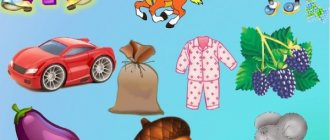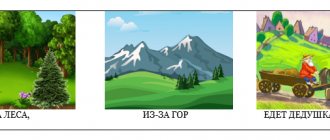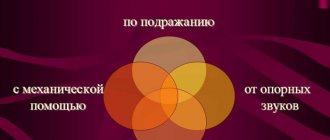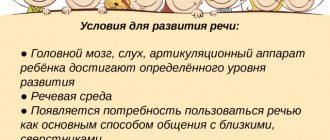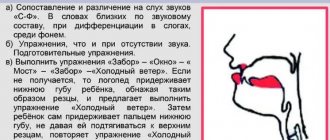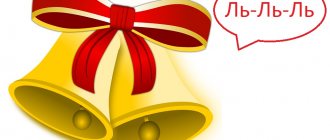Sound automation Presentation for a speech therapy lesson (middle group)
Slide 1
Sound F Podrezova Elena Yuryevna teacher-speech therapist MKDOU TsRR-DS "RITHM", Otradnoe village, Novousmansky district, Voronezh region
Slide 2
Articulation of sound The lower lip is close to the edges of the upper incisors, a narrow gap remains in the middle for the passage of air, the upper lip is slightly raised. The upper incisors are visible, the lower incisors are covered by the lower lip. The position of the tongue depends on the next vowel sound. The soft palate is raised, the vocal folds are open, the air stream is scattered
Slide 3
Repeat the syllables. Fa - fa - fa Fa - fo - fu - fy Yf - yf - yf Fo - fo - fo Fy - fu - fa - fo Af - af - af Fu-fu-fu Fo-fafufy Of-of -of Fy - fy - fy Fu - fo - fy - fa Phew - Phew - Phew Repeat the words. Sound at the beginning of a word: Fact, veil, fauna, fashion, beans, phase, pheasant, torch, headlight, fakir, factor, farce, minced meat, factory; snort, snort; background, photo, Thomas, fund, fountain, focus, lantern, form; fu, fugue, pound, poundik, land mine, football, wagon, van, wine glass.
Slide 4
Sound in the middle of a word: Sofa, drying oil, harp, count, Pythagoras, sundress, layman; sofas, reefs, harps; gramophone, telephone, pathos, tape recorder, reform, props; typhoon, embarrassment. Sound at the end of a word: Pif, bang, myth, boa constrictor (ph), closet, lion (ph), sleeve (ph), scarf, vulture, count, photographer, cliff (ph), rush (ph), giraffe. Confluence of consonant sounds in syllables and words: Fta, ft; fla, flo, flu; fra, fro, fra, fra; fta, fta. Jacket, caftan, lifts, sweaters; flag, bottle, flagship, pennant, flannel; navy, phlox, naval; tailcoat, frau, franc, transom, phrase, figure; front, Frosya; fruit, fruity, numbers.
Slide 5
Repeat the sentences. The fakir showed a trick. The Count carries a torch. The lights are on in the factory. Foma puts the scarf in the closet. Funtik snorts. The sundress has a good style. Pif and Paf are photographers. Thomas has a flag. The Count put on a tailcoat. Thomas has fruit. Frosya has a flag. Frosya has a flannel jacket. Foma has a caftan, Frosya has a beautiful jacket. Foma bought a phone. Repeat the tongue twisters. Pif has a guest - Paf. Fanya has a sweatshirt. Paf has a guest - Pif. Petya has shoes. The fleet is sailing to its native land, a flag on every ship. Repeat the riddle. He is tall and spotted, With a long, long neck, And he eats leaves - Leaves from the trees. (Giraffe) This eye is a special eye. He will quickly look at you, And the most accurate portrait of you will be born. (Camera) The players accurately throw punches at me with their feet. (Soccer ball)
Slide 7
Repeat the sentences. The fakir showed a trick. The Count carries a torch. The lights are on in the factory. Foma puts the scarf in the closet. Funtik snorts. The sundress has a good style. Pif and Paf are photographers. Thomas has a flag. The Count put on a tailcoat. Thomas has fruit. Frosya has a flag. Frosya has a flannel jacket. Foma has a caftan, Frosya has a beautiful jacket. Foma bought a phone. Repeat the tongue twisters. Pif has a guest - Paf. Fanya has a sweatshirt. Paf has a guest - Pif. Petya has shoes. The fleet is sailing to its native land, a flag on every ship. Repeat the riddle. He is tall and spotted, With a long, long neck, And he eats leaves - Leaves from the trees. (Giraffe) This eye is a special eye. He will quickly look at you, And the most accurate portrait of you will be born. (Camera) The players accurately throw punches at me with their feet. (Soccer ball)
Slide 8
Game "Give me a word." The speech therapist teacher invites the child to listen to poems and suggest the right words at the end. Holiday, holiday at the gate. Who will go to meet him? Me and my faithful friend - Little Red... (flag). Who scored a goal today? When I played ... (football). It's almost evening, look - The lights are on... (lanterns).
Slide 9
Game "One-Many". The speech therapist teacher names the object in the singular, and the child in the plural. Pheasant - (pheasants) Van - (vans) Torch - (torches) Telephone - (telephones) Focus - (tricks) Sundress - (sundresses) Fountain - (fountains) Count - (counts) Retell the story. The speech therapist teacher invites the child to listen to the story and then retell it. Foma, Afonya and Frol went for a walk. Foma and Afonya began to play football. Frol did not want to play football. He approached the stream and began to launch the boats. There were three ships in the flotilla. Every ship had a flag. The ships were so beautiful. Foma and Afona really liked Frol’s play, and the guys also began to launch ships.
Slide 10
We wish you success!!!
Presentation “Automation of modern production”
Slide 1
Completed by: Yasko Lev Municipal Educational Institution “Secondary School No. 9 of Nadym” AUTOMATION IN MODERN PRODUCTION
Slide 2
Automation is one of the main directions of scientific and technological progress and an important means of increasing the efficiency of social production. Modern industrial production is characterized by large scale and complication of technological processes, an increase in the unit capacity of individual units and installations, the use of intensive, high-speed modes, increased requirements for product quality, personnel safety, safety of equipment and the environment. The cost-effective, reliable and safe operation of complex industrial facilities can be ensured using only the most advanced principles and technical controls.
Slide 3
Modern trends in production automation are: the widespread use of computers for control, the creation of machines and equipment with built-in microprocessor means, control and regulation measurements, the transition to centralized control structures with microcomputers, the use of highly reliable technical means, automated design of control systems. One of the most important tasks is the widespread introduction of automated and automatic process control systems in non-ferrous metallurgy.
Slide 4
Automation of processes allows solutions to be both social; as well as technical and economic problems. Many years of experience in operating control systems at metallurgical enterprises have shown that automation makes it possible to increase the productivity of metallurgical units as a result of stabilizing their operating modes; increase the yield of finished products due to more precise control of the technological process; reduce the consumption of raw materials, fuel materials, energy per unit of production, increase labor productivity.
Slide 5
Automation, with the exception of the simplest cases, requires an integrated, systematic approach to solving a problem. Automation systems include sensors, input devices, control devices (controllers), actuators, output devices, and computers. The computational methods used sometimes copy the nervous and mental functions of humans. This entire set of tools is usually called systems.
Slide 6
The following elements of equipment automation are distinguished: 1. Numerical program control - the structure of automation and control of drives of machine tools and other technical devices. Such a system appeared in the middle of the last century, but CNC became widespread only recently, with the active introduction of microprocessors.
Slide 7
2. Production robots. The first use of robots in industry occurred in the 60s. XX century. Since then, robots have been actively used in various production processes.
Slide 8
3. Mobile production devices - designed for changing tools and processed metal parts. Typically, such actions are performed by robots under computer control. Tool shop
Slide 9
4. Automated warehouse devices - special mobile lifts that, on command, can move objects into or remove them from the warehouse. .
Slide 10
5. Quality control devices. Such systems are designed to check the quality of certain metal products. Certain characteristics of the objects being tested are compared with reference parameters, and the percentage of compliance with specified standards (percentage of quality) is determined. This check is carried out by the computers themselves or by automated equipment controlled by these computers.
Slide 11
6. Computer-aided design programs and devices are used by developers and administrators in the process of modeling products or creating technical documentation.
Slide 12
Automated planning Consists of linking individual elements of the plan. This linking is carried out according to the following principles: • Qualitative homogeneity of the measured objects • Homogeneous communication channels between them • Compatibility of connections.
Slide 13
The largest direction in the field of equipment automation is the creation of machine tools with numerical control (CNC). Such tanks are designed for processing metals , sheet metal, pressure processing of materials, and, less commonly, for processing wood and plastics. Modern roll forming equipment is often equipped with a numerical control system.
Slide 14
Automation of a technological process is a set of methods and means designed to implement a system or systems that allow the control of the technological process itself without direct human participation, or leaving the right to make the most responsible decisions to a person. Computerization is the widespread introduction of electronic computers into various spheres of human activity (for example, for managing technological processes, transport, production). Automation of the programming process is the removal of humans from the process of writing program code, either completely or partially. Achieved by: 1) Development of tools for formulating and setting a task from a person to a machine (human-machine language). 2) Presentation of the means of this tool in terms of the area of specialization of the human operator. 3) development of an input data analyzer and generation of final code in a machine-level language. 4) Integration of accounting and error correction systems (AI systems). Production automation is a process in the development of machine production in which management and control functions previously performed by humans are transferred to instruments and automatic devices.
Slide 15
SOURCES: Great Soviet Encyclopedia Wikipedia - free encyclopedia Internet resources: Google.ru
Presentation “Sound Staging and Automation [K]”
Diana Fedyushina
Presentation “Sound Staging and Automation [K]”
Goal: Staging and Automating the sound “K”
Tasks:
— Prepare the articulatory apparatus for producing the sound K
-Form articulatory sound
-Learn to pronounce the sound “K” in syllables, at the end of a word, at the beginning of a word, in pure phrases, in poetry.
-Development of phonemic hearing
-Development of memory, attention, perception.
Articulation of the sound "K"
The position of the lips depends on the following vowel. The tip of the tongue is lowered, moved away from the lower incisors deep into the oral cavity, the back of the back of the tongue is steeply arched upward and forms a bridge with the surface at the border of the hard and soft palate. The soft palate is raised. Vocal folds are open (K - dull sound )
.
Sound setting [k]
1. By imitation.
The speech therapist shows and explains to the child the articulatory structure (bend the tongue like a fist)
.
Then he asks questions: “How does the hen call the chickens?”
The child answers:
“Ko-ko-ko
.
“How does a frog croak?”
-
“Heron heron”
.
2. Mechanically.
The child should pronounce the syllable [ta] with a spatula, lightly press on the tip of the tongue, then move the tongue away
3 slide; pronounce the sound “K” when the blue circle appears
4 slide - automation of the sound “k” at the end of a syllable (ak, words (poppy, lac, cancer)
5 slide - automation of the sound “k” at the end of a syllable (yk, words (bull, tongue, kebab)
6.7 slide automation of the sound “k” at the end of a syllable (ok, words (juice, castle, sock, wreath, bag, net)
8.9 slide automation of the sound “k” at the end of a syllable (uk, words
10 slide automation of the sound “k” at the end of a syllable (ik, words
11 slide automation of the sound “k” at the end of a syllable (yak, words
12 slide automation of the sound “k” at the end of a syllable (yuk, ek, words (turkey, man, check)
13 slide automation of the sound “k” in verses
14, 15 slide automation of the sound “k” in an open syllable (ka, in the middle of a word
slide automation of the sound “k” in an open syllable (ko, in the middle of a word
16 slide automation of the sound “k” in the words far-close, high-low (vocabulary expansion, spatial orientation)
17 slide automation of the sound “k” in the words far-close, high-low
18 slide automation of the sound “k” in an open syllable (ka, at the beginning of a word
19 slide automation of the sound “k” in an open syllable (ko, at the beginning of a word
20 slide automation of the sound “k” in an open syllable (ku, at the beginning of a word
21 slides automation of the sound “k” in verses
Automation sequence (slides)
can be changed depending on the individual characteristics of the children
